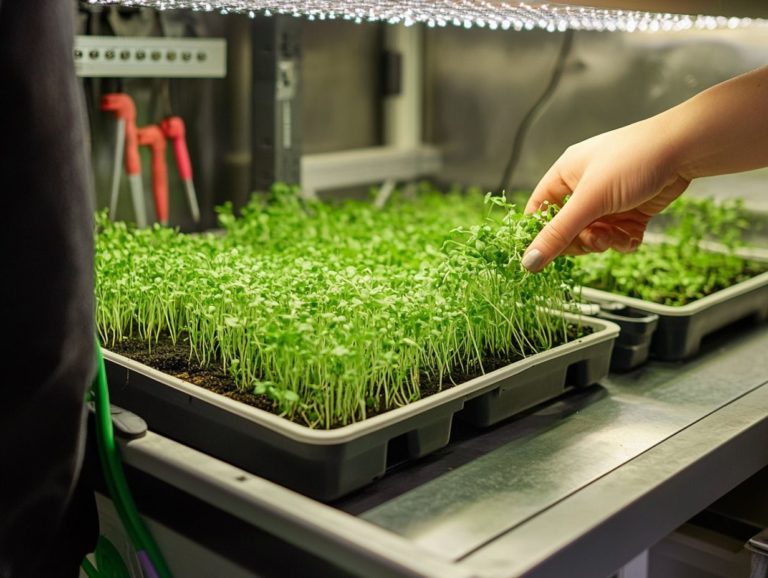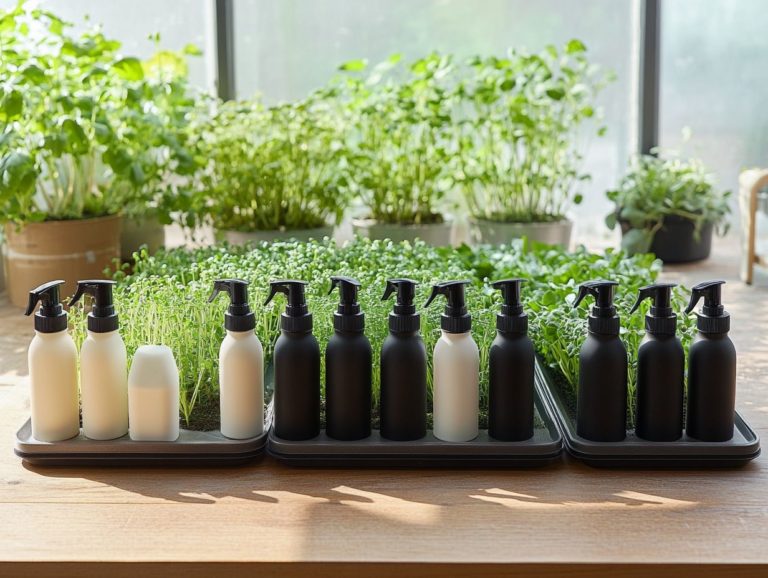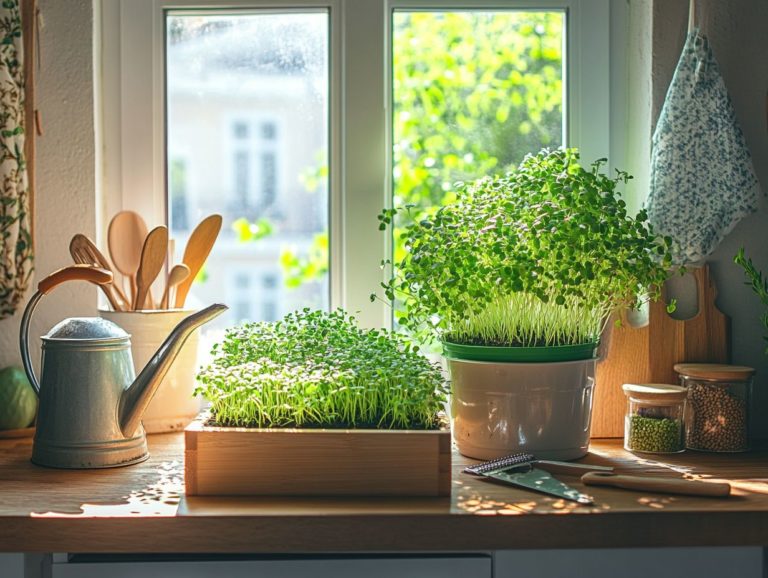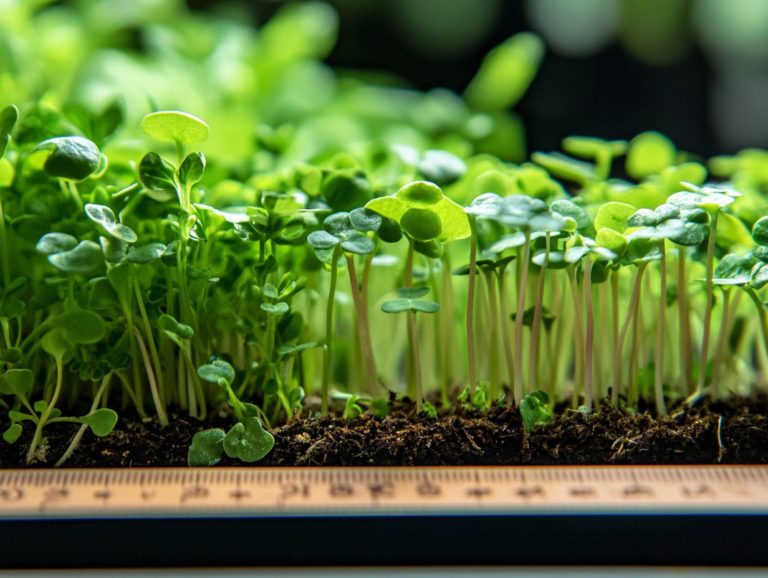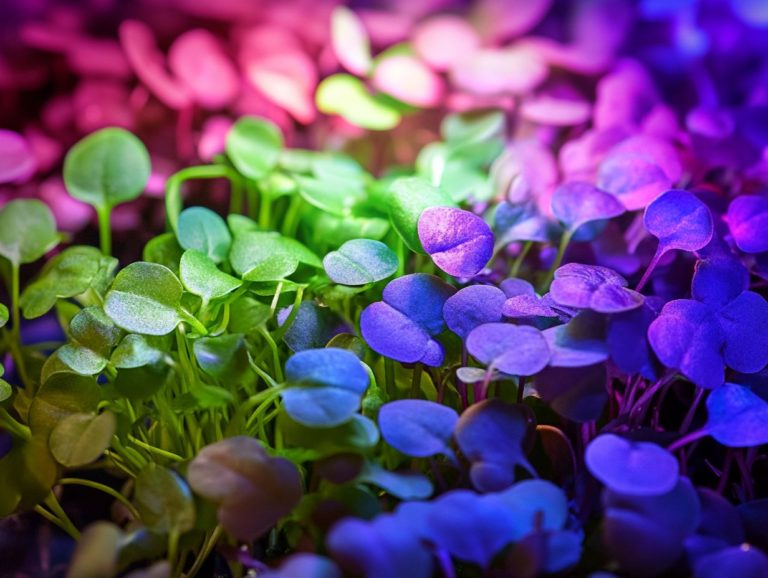How to Choose the Right Microgreen System
Microgreens are tiny, nutrient-packed plants. They infuse dishes with vibrant flavors and many health benefits.
Explore various growing systems for these lively greens at home.
This guide will walk you through the essentials of understanding microgreens, highlighting their benefits and detailing the different systems soil-based, hydroponic, and aeroponic. You can select the ideal option that complements your space and lifestyle.
Get ready to discover valuable tips for maintaining your microgreen garden and maximizing your harvest.
Prepare to elevate your meals and enhance your well-being!
Contents
- Key Takeaways:
- Understanding Microgreens
- Types of Microgreen Systems
- Factors to Consider When Choosing a Microgreen System
- Key Features to Look for in a Microgreen System
- Tips for Maintaining and Maximizing Your Microgreen System
- Frequently Asked Questions
- Curious about microgreens? Here s why you should grow them!
- What are the different types of microgreen systems available?
- How do I determine which microgreen system is right for me?
- Do I need any special equipment to grow microgreens?
- How often should I water my microgreens and how much light do they need?
- What are some common mistakes to avoid when choosing a microgreen system?
Key Takeaways:
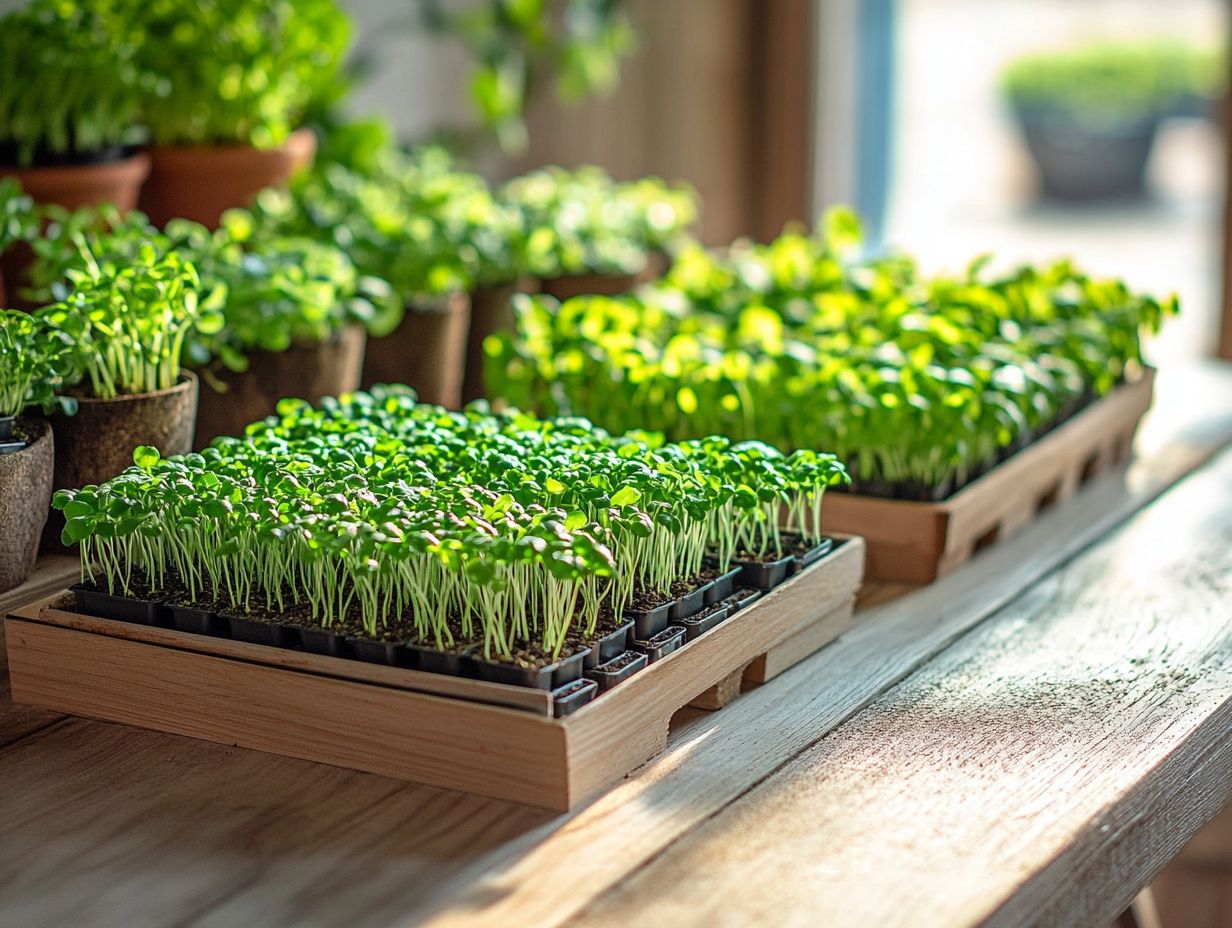
- Consider your space and budget when choosing a microgreen system, and think about the level of maintenance and types of microgreens you want to grow.
- Look for key features such as proper lighting, an efficient watering system, and suitable trays and containers when selecting a system.
- Proper care, maintenance, harvesting, and replanting techniques are crucial for maximizing the potential of your chosen microgreen system.
Understanding Microgreens
Understanding microgreens is essential for anyone wanting to enrich their diet. These vibrant seedlings are harvested just after their first true leaves appear.
Packed with a wealth of nutrients and flavor, microgreens have captured the attention of health-conscious individuals and professional chefs alike. As Francesco Di Gioia from Penn State highlights, growing these tiny greens is remarkably straightforward, even in the confines of a small kitchen.
With tools like grow trays at your disposal, you can cultivate a sustainable source of fresh vegetables that will thrive well into 2024.
What are Microgreens?
Microgreens are the delectable seedlings of vegetables and herbs, harvested shortly after germination typically within 7 to 21 days after planting.
These vibrant little wonders come in a delightful array of varieties, such as radish, beet, arugula, and basil, each bringing its own unique flavors and nutritional perks to the table. To cultivate these tiny greens effectively, selecting high-quality seeds is essential, with organic options being the cr me de la cr me. Organic seeds improve germination rates and ensure a healthier end product, free from harmful pesticides.
It’s also vital to differentiate microgreens from sprouts. While both are young plants, sprouts are simply germinated seeds without leaves. In contrast, microgreens boast actual leaves, dramatically enhancing their flavor and nutrient density.
Benefits of Growing Microgreens
Growing microgreens offers benefits like enhanced nutrition and convenience, especially in compact spaces. They are perfect for urban gardening and large families eager to incorporate fresh greens into their meals.
These tiny powerhouses are brimming with vitamins, minerals, and antioxidants, often surpassing their mature counterparts. Not only do they promote a healthier diet, but they also introduce vibrant flavors and textures to your dishes.
If you’re considering cultivating microgreens at home, adopting simple bottom watering methods will ensure even moisture distribution. Using the best containers for microgreen cultivation with drainage holes is essential to prevent over-saturation. This strategy promotes robust growth, resulting in a generous supply of nutrient-rich greens that can elevate your culinary adventures.
Types of Microgreen Systems
You ll discover a variety of microgreen systems that cater to your individual gardening preferences and available space. These include soil-based systems, hydroponic setups, and aeroponic systems, each presenting unique advantages for cultivating these nutrient-rich greens.
Whether you prefer the simplicity of soil or the innovation of hydroponics, find the best option for your needs today!
Soil-Based Systems
Soil-based systems for growing microgreens rely on a high-quality growing medium, like coco coir. This medium excels in water retention and aeration while providing proper drainage through thoughtfully placed holes.
This organic substrate fosters healthy root development and allows the use of organic seeds, elevating the overall quality of your microgreens. One significant perk of these systems is their ease of care. They require less frequent monitoring compared to hydroponic setups, making them ideal for those learning How to Use Hydroponics for Microgreens.
Choosing the right soil mix is essential as it directly affects growth rates and nutrient availability. By maintaining optimal moisture levels, you can prevent issues like mold and create an environment where your microgreens can thrive, ultimately leading to an abundant harvest.
Hydroponic Systems
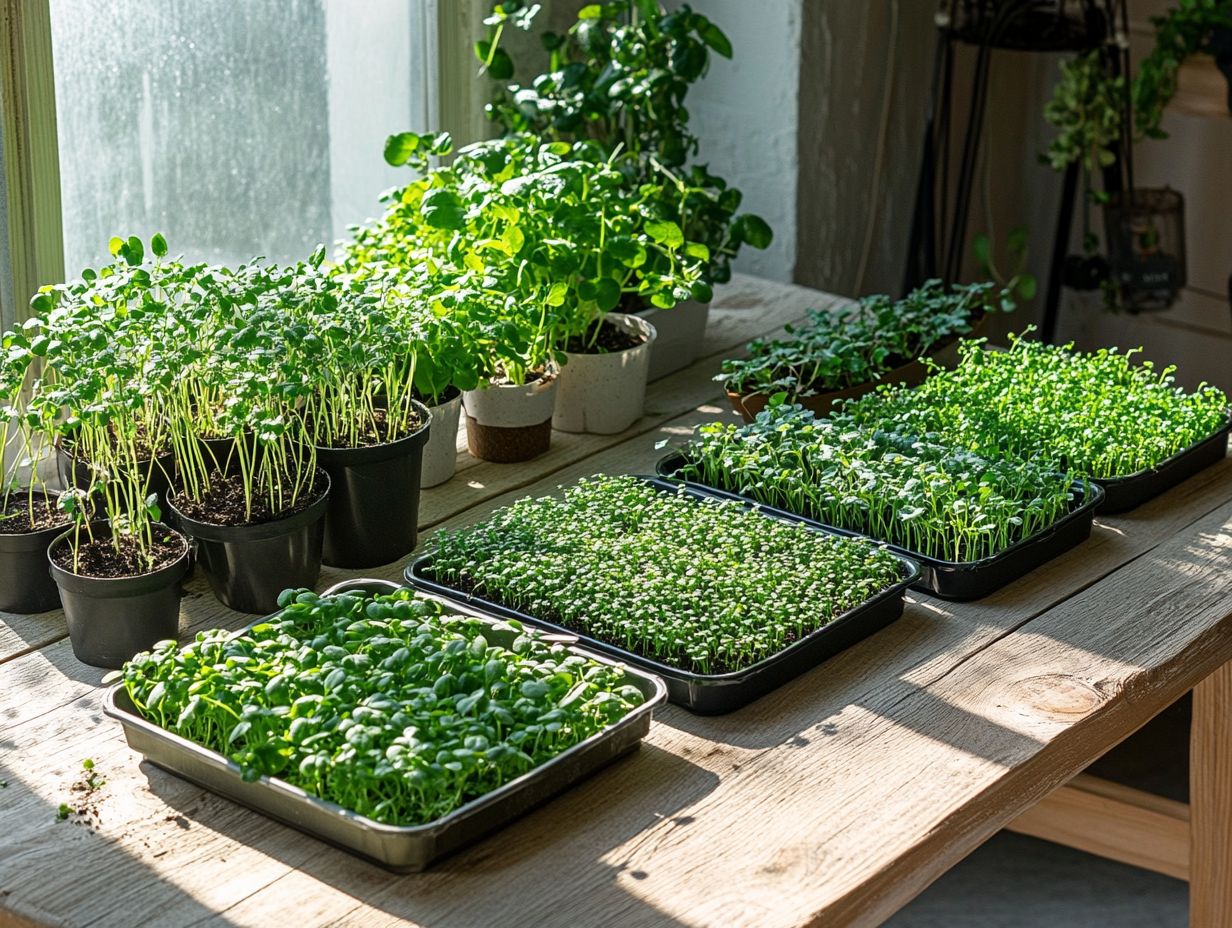
Hydroponic systems offer an innovative way to cultivate microgreens. They deliver nutrients directly to the plants via a water source, eliminating the need for traditional soil.
This method accelerates growth rates significantly compared to conventional gardening and maximizes space efficiency. It s perfect for urban environments where space is limited. Consider using food-safe plastic containers for your hydroponic setup.
As you embark on your hydroponic journey, focus on maintaining optimal nutrient levels and pH balance. These elements are vital for the health of your plants. Regularly test the water and adjust the nutrient solution to ensure your microgreens thrive.
Incorporating essential components, like high-quality grow lights and a dependable aeration system, will enhance your hydroponic setup. This leads to healthier and more robust crops, especially when using artificial light.
Aeroponic Systems
Aeroponic systems leverage cutting-edge misting technology to cultivate microgreens. This method provides optimal air circulation and nutrient delivery to seedlings without traditional growing mediums.
By creating a precisely controlled environment where roots are bathed in nutrient-rich mist, these systems significantly boost growth rates and yields. The addition of artificial light enables year-round cultivation, translating to quicker germination and healthier plants.
The ideal conditions for aeroponic systems involve meticulously regulated temperature and humidity levels. This creates a perfect backdrop for seedling development. These systems are particularly advantageous in urban settings where space is at a premium. The ability to grow fresh produce vertically can profoundly enhance local food sustainability.
Factors to Consider When Choosing a Microgreen System
When choosing a microgreen system, consider several key factors that will influence your decision:
- Available space: Evaluate the space you have for gardening.
- Budget constraints: Identify any financial limitations you may face.
- Maintenance level: Determine how much upkeep you’re prepared to commit to.
- Specific types of microgreens: Think about what types you want to grow.
These considerations will guide your selection process and ensure your gardening experience is both enjoyable and fruitful.
Space and Budget
Evaluating your available space and budget is crucial when deciding how to grow microgreens. This is especially important if you re working with a small kitchen or an apartment with limited gardening room.
In these cozy environments, opting for vertical gardening solutions can significantly boost productivity without cluttering surfaces. This allows your plants to thrive in a well-organized setup. Compact trays maximize every square inch while ensuring efficient sunlight use.
You can keep costs down by repurposing everyday items and investing in multi-layered systems. This minimizes initial expenses while providing everything needed for successful growth.
These straightforward strategies not only address space limitations but also promote a sustainable approach to urban gardening that you can feel proud of. Start your microgreen garden today for fresh and delicious produce!
Level of Maintenance
The level of maintenance needed for growing microgreens can vary depending on the system you choose. If you opt for simpler bottom watering techniques, you’ll find it easier to manage your crops, especially as a beginner.
Take hydroponic systems, for example. They often require more of your attention since you need to monitor nutrient levels and the acidity or alkalinity of your water. Establishing a routine to check water quality and track your microgreens’ growth progress is crucial.
Soil-based systems might offer a bit more flexibility, but they still demand regular watering to keep the soil from drying out completely. No matter which method you choose, watch for signs of wilting or discoloration, as these could signal issues like overwatering or inadequate light.
By implementing a straightforward care schedule, you’ll see your microgreens thrive and yield the best results.
Types of Microgreens to Grow
Selecting the right types of microgreens to grow is crucial for ensuring a diverse and nutritious harvest. Popular choices include pea shoots and other seedlings that flourish across various systems.
These microgreens do more than just add a pop of color to your dishes; they also introduce unique flavor profiles that elevate your culinary creations. For example, radish microgreens deliver a delightful peppery kick, while sunflower shoots offer a mild, nutty taste that s hard to resist.
To achieve the best results, aim for ideal growing conditions think well-drained soil, adequate light, and consistent moisture to promote robust growth. When sourcing organic seeds, look no further than your local gardening stores or reputable online suppliers; they re great starting points to ensure quality.
Reflecting on your personal cooking style can also help guide your selections. If you want a fresh salad topper, leafy varieties like arugula may be your go-to. Alternatively, if you want to explore more exotic flavors, consider incorporating wasabi or mustard greens into your repertoire.
Key Features to Look for in a Microgreen System
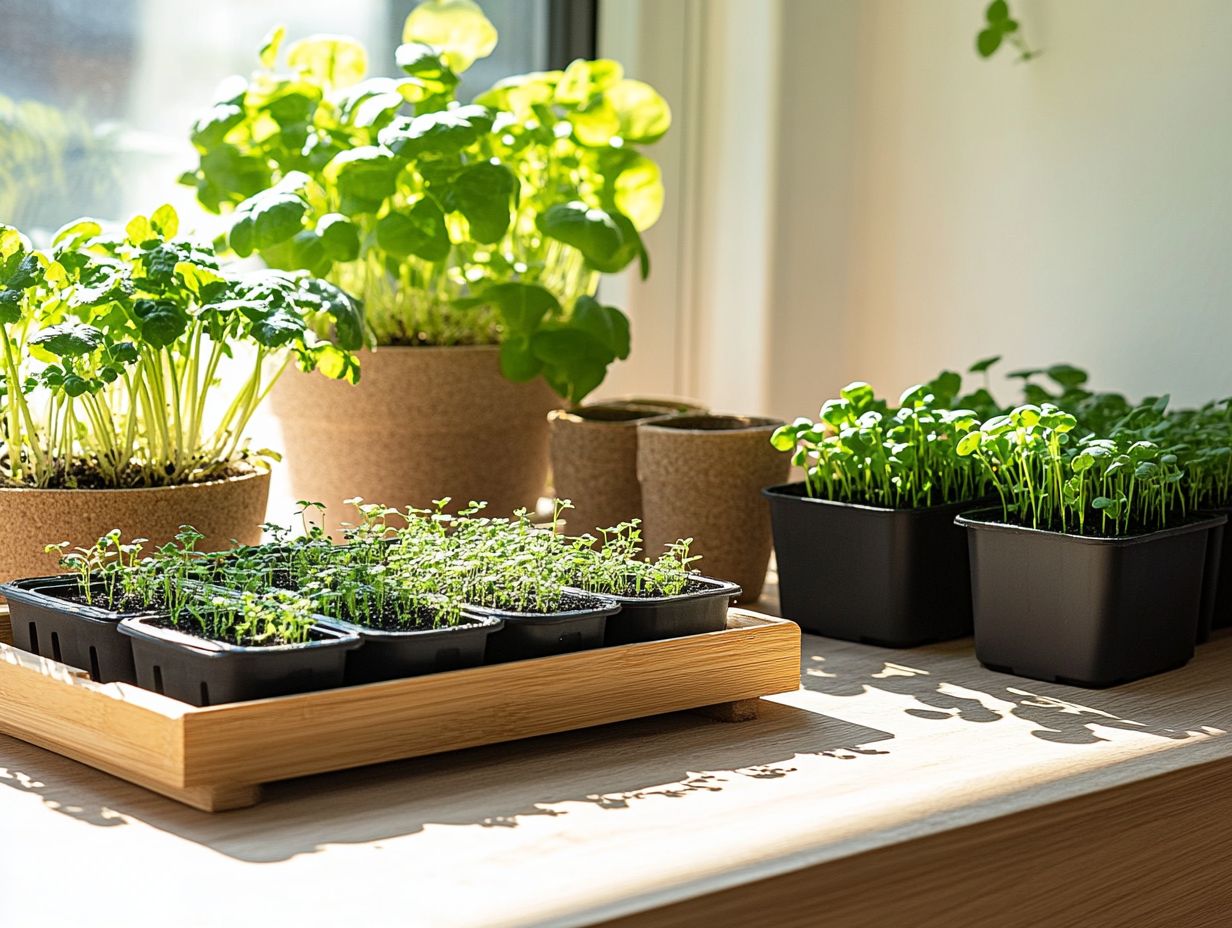
When assessing a microgreen system, it’s essential to consider several key features.
Pay attention to the lighting options, as they play a crucial role in growth. Make sure to evaluate the efficiency of your watering system to ensure your greens receive just the right amount of hydration.
Take note of the trays and containers used. Opt for those made from food-safe plastic, which is vital for maintaining optimal safety.
Lighting
Lighting plays a pivotal role in the successful cultivation of microgreens, allowing you to grow them indoors regardless of the natural sunlight at your disposal.
When choosing between LED and fluorescent lighting, consider how each option can affect the vibrancy and yield of your delicate plants. LED lights stand out for their energy efficiency and lower heat output, making them perfect for close proximity to your greens. On the other hand, fluorescent lights tend to be more budget-friendly and can illuminate larger areas effectively.
To maximize your microgreens’ growth, position the lights about 6-12 inches above them. This ensures they receive the right amount of light without burning. A light duration of 12-16 hours per day is typically recommended, closely mimicking the natural light cycle these fast-growing greens thrive on.
Watering System
An effective watering system, such as easy bottom watering, ensures that your microgreens receive just the right amount of moisture while preventing the dreaded over-saturation and root rot, thanks to trays equipped with proper drainage holes.
By employing techniques like misting or using a spray bottle to gently moisten the soil surface, you create an optimal environment for these delicate plants. Consistent moisture management is crucial; implementing a timer for automated watering can bring substantial benefits. It not only reduces the time spent on daily maintenance but also helps maintain the perfect moisture level throughout the germination process.
Moreover, using moisture-retentive substrates can significantly enhance the effectiveness of these watering methods, enabling you to nurture flourishing, healthy microgreens with minimal effort.
Trays and Containers
Choosing the right trays and containers is crucial for growing microgreens. A variety of options are available, from propagation trays to larger systems crafted from food-safe plastic, ensuring the safety of your crops.
The trays you select significantly influence the overall growth and health of your microgreens. For instance, propagation trays, which are typically smaller and shallower, are perfect for starting seedlings. They allow for excellent airflow and drainage, helping to prevent root rot, a real enemy when growing microgreens. To enhance your setup, consider reading more about how to choose the right soil for microgreen growth.
Conversely, deeper trays provide ample space for more extensive root systems, accommodating your plants as they grow. Regarding durability, tray materials vary. Sturdy plastic trays offer longevity and reusability, while biodegradable options refer to trays that break down naturally over time and appeal to environmentally-conscious growers.
Drainage holes are essential; they prevent excess water retention and play a vital role in fostering optimal microgreen development. If you’re interested in maximizing your gardening potential, check out our guide on how to grow microgreens in a small space. With the right choices, you’re setting the stage for a thriving microgreen garden!
Tips for Maintaining and Maximizing Your Microgreen System
Proper maintenance and care are essential for maximizing your microgreen system. By ensuring you attend to every detail, you can enjoy a continuous and abundant harvest while employing effective harvesting and replanting techniques.
Proper Care and Maintenance
To cultivate flourishing microgreens, you must prioritize proper care and maintenance, including consistent watering.
Your plants need ample light exposure throughout their growth cycle. These small yet vibrant plants benefit from daily checks to assess moisture levels; they flourish in a well-hydrated environment, provided you avoid waterlogging.
Monitoring light conditions is equally important. Ideally, your microgreens should bask in 12-16 hours of indirect sunlight or fluorescent light each day to promote healthy growth.
If pests appear, consider employing organic pest control methods like neem oil or insecticidal soap. These options are effective while remaining gentle enough not to harm your delicate microgreens.
By following this comprehensive regimen, you ll be well on your way to a fantastic yield of nutrient-dense greens!
Harvesting and Replanting Techniques
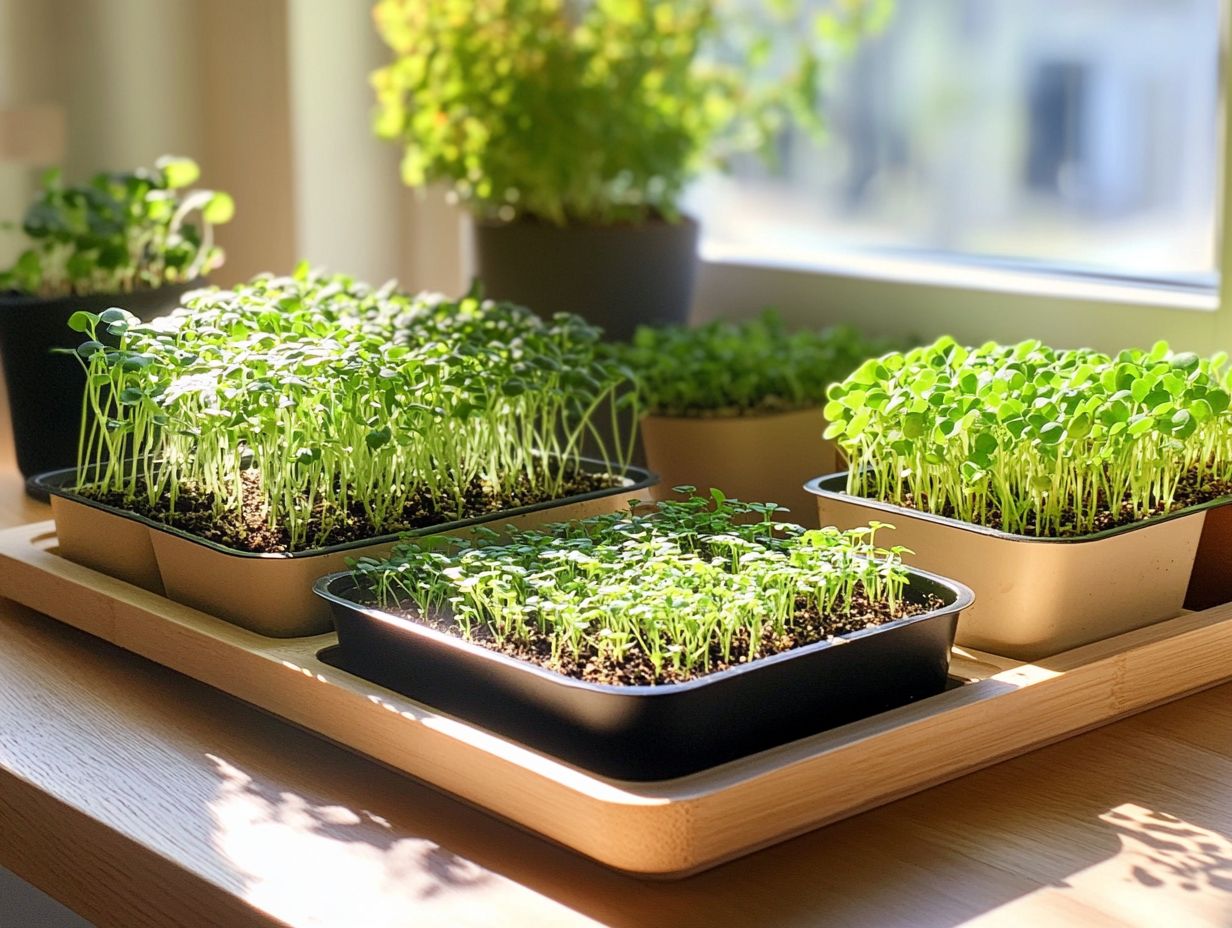
Harvesting microgreens at the right moment is essential for maximizing both flavor and nutrients. By employing effective replanting techniques, you can ensure a steady supply of fresh seedlings.
The sweet spot for harvesting usually falls between 7 to 21 days after germination, depending on the specific variety you re cultivating. Each type of microgreen reaches its peak taste profile at different growth stages, often signaling readiness with vibrant colors and well-developed leaves.
When you re ready to cut, using sharp, sanitized scissors is key. This prevents damage and allows for a clean cut just above the soil line.
After harvesting, preparing your trays for replanting involves meticulously cleaning out any leftover soil and debris, followed by a fresh layer of quality growing medium. This sets the stage for the next wave of microgreens to thrive beautifully.
Frequently Asked Questions
Curious about microgreens? Here s why you should grow them!
Microgreens are young, edible plants harvested just after the first leaves have developed. They are packed with nutrients and have a high concentration of flavor, making them a popular addition to salads, sandwiches, and other dishes. Additionally, they are easy to grow and can be done so year-round, making them a great addition to any home garden.
What are the different types of microgreen systems available?
There are several types of microgreen systems available, including tray systems, hydroponic systems, and vertical systems. Tray systems are the most common and involve growing microgreens in shallow trays filled with soil.
Hydroponic systems grow plants in nutrient solutions without soil, while vertical systems allow for vertical stacking of trays for efficient use of space.
How do I determine which microgreen system is right for me?
When choosing a microgreen system, consider your space, budget, and personal taste. A vertical system is great for limited areas, while a hydroponic system is perfect for low maintenance.
Research different options and read reviews to find what suits you best. Enjoy the process of selecting the right system!
Do I need any special equipment to grow microgreens?
You don t need specialized tools to grow microgreens. Basic gardening items like trays, soil, and light will work just fine.
If you’re resourceful, use plastic containers or egg cartons at home. Get creative and have fun!
How often should I water my microgreens and how much light do they need?
Water your microgreens once a day. The exact amount can change based on your system and the microgreen type.
They thrive with 6-8 hours of sunlight each day. If you use artificial light, provide around 12-16 hours for best results.
What are some common mistakes to avoid when choosing a microgreen system?
A big mistake is getting a system that’s too large for your space or budget. Always check reviews to ensure quality.
Follow instructions carefully for watering and light to avoid issues like mold or stunted growth. Keep your microgreens healthy and vibrant!

